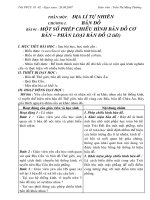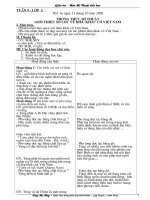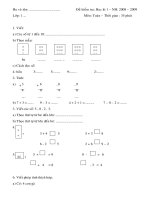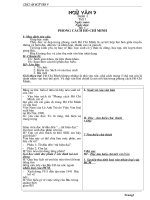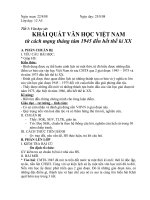1 5 5 telephone talk (realistic fiction)
Bạn đang xem bản rút gọn của tài liệu. Xem và tải ngay bản đầy đủ của tài liệu tại đây (34.8 KB, 2 trang )
Telephone Talk
by Ahmed Hassan
ELL Reader 1.5.5
Realistic Fiction
INTRODUCE THE BOOK
RESPOND
Activate Prior Knowledge/Build
Background Read the title, and discuss
what the boy and his grandmother are doing.
Invite children to share their experiences with
telephones. Tell children this book describes how
to use the telephone.
Answers to the Reader’s Inside Back Cover:
Preview/Use Text Features Preview the
reader by talking about the photographs together
and naming the labeled items.
Preteach Vocabulary Review the tested
vocabulary words that appear in this book:
learn and through. Introduce these key words
from the book: telephone (p.1), listen (p. 2),
rings (p. 2), and answer (p. 3). Discuss these
words and add them to a Word Wall.
READ THE BOOK
Choose among these options for reading to
support children at all English proficiency levels.
Read Aloud Read the book aloud as children
follow along. Pause to verify comprehension and
to explain unfamiliar concepts.
Monitored Reading Have children read
aloud a few pages at a time. Use the following
questions to support comprehension:
• Pages 2–3 What does it mean when the
phone rings? (It means someone is calling
and wants to talk.)
• Pages 4–6 Does a phone always have
a cord? (No, cordless phones do not have
cords.)
• Pages 7–8 What do you do when
someone else is talking on the phone? (Be
polite. Do not make noise.)
Talk About It
1. Answers will vary.
2. Possible answers: People can talk to friends
and family. They can call for help in an
emergency. They can call a repairman or request
a food delivery.
Write About It
3. Answers will vary.
Support writers at various English proficiency
levels.
Beginning Provide these sentence frames:
I can call
. I will say
. Ask children to
dictate an ending. Write each sentence, and
then read them aloud. Encourage children to
repeat after you.
Intermediate Have children look in the book
for words they can use in their writing.
Advanced Encourage children to help lessproficient speakers brainstorm words to use in
their writing.
Extend Language Say hello when you answer
the phone. Say good-bye when you hang up.
People may also ask: How are you? or May I
help you?
Answers to page 58:
Possible answers: Hello! Hola! Yes? Good
morning!
Family Link Read aloud the Family Link activity
on page 58 before sending copies of the Study
Guide home with children. Later, have them say
how their families answer the phone in their
home language.
© Scott Foresman 1
Reread Have children reread the book with a
partner, in small groups, or independently. Have
them complete the Study Guide on page 58.
ELL Readers Teaching Guide
Unit 5, Week 5 Telephone Talk
57
Study Guide
Telephone Talk
Name
• Read Telephone Talk again.
• Draw yourself answering the phone. What do you
say when you pick up the phone? Write it.
How does your family answer the phone in your
home language?
58
Telephone Talk Unit 5, Week 5
ELL Readers Teaching Guide
© Scott Foresman 1
Family Link
